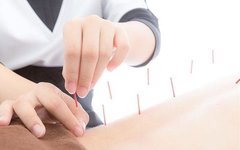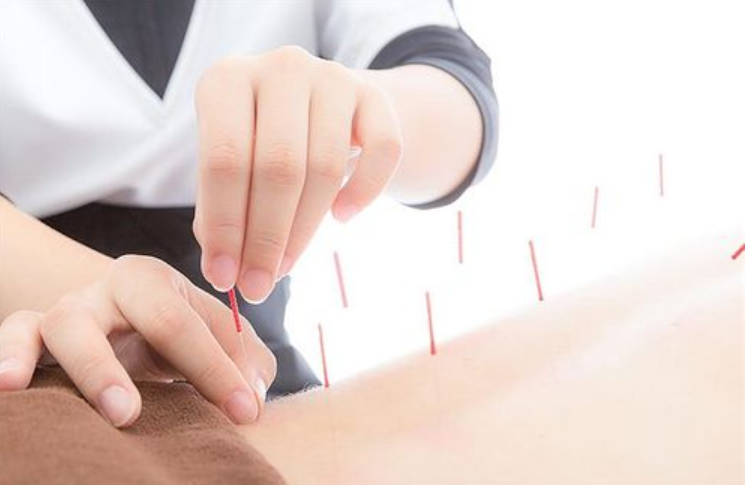
Acupuncture Image from the Internet
When mentioning acupuncture, most people will picture the image shown above. However, did you know that this is actually just one member of the acupuncture family, called “mào zhēn (fine needle)”. The fine needle is almost synonymous with TCM acupuncture and is the most commonly used tool in modern acupuncture therapy. From its appearance, it can be seen that this type of needle is very thin, thin enough to resemble the mouth of a mosquito or a horsefly (“rú wén huǐ” 《Huangdi Neijing·Lingshu·Nine Needles and Twelve Origins》):
The fine needle is as thin as a mosquito’s mouth. Such a thin needle cannot be used for all diseases. It is said that to meet complex treatment needs, Fuxi (approximately 4000 to 5000 years ago) created different acupuncture tools based on bian stone therapy (originating from the Neolithic era), totaling nine types, collectively known as “jiǔ zhēn (nine needles)”. This indicates that since then, people have begun to use metal needles for healing, and developed a systematic acupuncture theory that continues to this day.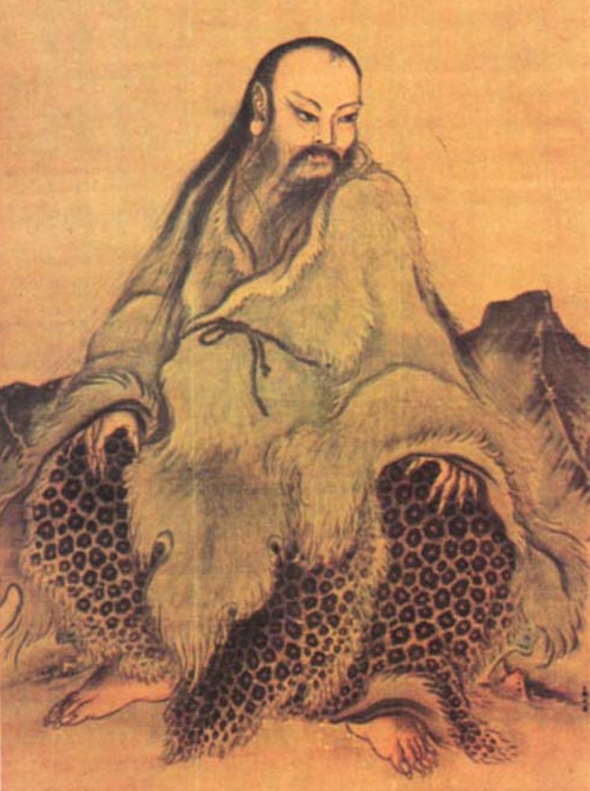
Fuxi Image from the Internet
The mythological figure Fuxi represents the laboring people of ancient times. The nine needles are actually the result of ancient physicians continuously accumulating experience and improving their tools through long-term medical practice.
“Nine needles” are first recorded in the 《Huangdi Neijing·Lingshu (Needle Classic)》, which are: chán (镵), yuán (员), dī (鍉), fēng (锋), pí (铍), yuán lì (员利), mào zhēn (毫针), cháng zhēn (长针), dà zhēn (大针), totaling nine brothers. The most familiar to us is the fine needle, which ranks seventh. What do they all look like? Let’s test our eyesight:
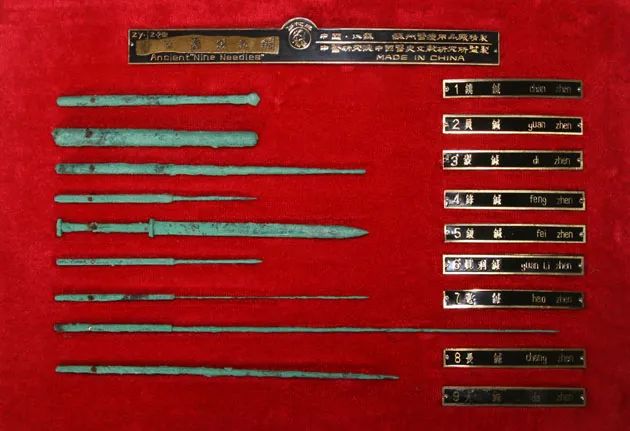
《Huangdi Neijing·Lingshu》 Nine Needles Image from the Internet
1. Chán needle, 2. Yuán needle, 3. Dī needle, 4. Fēng needle, 5. Pí needle, 6. Yuán lì needle, 7. Mào needle, 8. Cháng needle, 9. Dà needle
Careful little friends may have noticed that these nine brothers, aside from their height and thickness differences, are primarily distinguished by: the needle tip. This determines their functions and applicable ranges are completely different:

Chán, chán, “a sharp tool” according to the Shuōwén, refers to plow iron, specifically the plow head, which is sharp and heavy, and as a verb means to pierce or chisel.Chán needle, also known as “arrowhead needle” or “plow head needle”, is the eldest brother of the nine needles. The needle is 1.6 inches long (≈3.7 cm), with a bulging head and a sharp end, mainly used for shallow punctures on the body surface to dispel heat, treating febrile diseases and skin diseases.The widely used skin needle is developed based on the chán needle.

Yuán needle: 1.6 inches long, the needle body is cylindrical, as shown in the image, the tip of the yuán needle is not pointed, but oval-shaped, blunt and smooth, allowing it to slide easily between the flesh with minimal damage to superficial fascia and muscles. Its main characteristic is that it does not harm the muscles while dispersing evil qi between the flesh.

Dī needle, 3.5 inches long (≈8.1 cm), with a thick body, the tip is “sharp as millet”. “Millet” is similar to rice, commonly known as yellow rice; “zǔ” refers to millet after husking. “Millet” is used to describe the dī needle’s tip, which is small and round. During treatment, it mainly applies pressure on the skin surface of meridian points, hence it is also called “tuī zhēn” (pushing needle). It has the effect of unblocking meridians and tonifying qi and blood. It is widely used for various cold and deficiency syndromes, especially suitable for those afraid of needles, the elderly, the weak, pregnant women, and children.

Fēng needle: 1.6 inches long, the needle body is cylindrical, and the tip is sharp with three cutting edges, hence it is also known as “sān léng needle” (three-edged needle). The fēng needle is sharp and is often used for shallow punctures to draw blood, treating stubborn diseases. 《Lingshu·Guan Needle》 states: “For diseases in the meridians with chronic pain, use the fēng needle.” “Chronic pain” refers to pain that is difficult to cure. “Chronic diseases must have stasis” 《Lingshu·Shouyao Gangrou》 states: “If chronic pain persists, check the blood vessels, and release the blood.” This means that for long-standing pain, if there is evidence of blood stasis, the fēng needle should be used to directly release the stasis, which is the best and fastest way to regulate blood, better than using blood-activating and stasis-removing herbs, and without the side effects of medication. In treating some severe and chronic diseases, fēng needle puncturing blood often achieves miraculous effects.

Pí (pí), a double-edged knife, was a commonly used ancient weapon from the Warring States to the early Han dynasty. According to the Shuōwén: “Pí, a large needle. Also called, sword-like knife.” Pí needle, 4 inches long (≈9.3 cm), width two and a half fen, shaped like a precious sword, with blades on both sides, and the tip is sharp like a sword edge. It is mainly used to cut open abscesses and drain pus and blood.
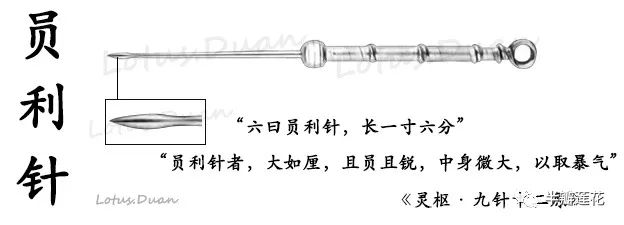
Yuán lì needle: 1.6 inches long, the needle body is small, the tip is slightly round and sharp, the back of the needle body is slightly thicker, and then slightly thinner. 《Lingshu·Nine Needles Theory, Chapter 78》 states: “Based on the tail of the yak, slightly larger at the end, smaller at the body, allowing for deep insertion.”Máo (máo), same as “牦”, according to the Shuōwén: refers to the tail of the yak. The shape of the yuán lì needle is likely similar, with a tip like a cow’s tail, round and sharp, the tip being the sharpest, the middle slightly thicker, and the back of the needle body being thinner, commonly used for treating acute diseases.

Mào needle: 3.6 inches long (≈8.3 cm). The needle is as fine as a mosquito’s mouth, allowing for gentle insertion into the flesh, with slight lifting and thrusting, mainly used for long-term retention of needles, waiting for qi to arrive, thus achieving the effects of tonifying the body and expelling evil, often used to treat conditions like painful obstruction.

Cháng needle: The tip is sharp, while the needle body is thin and long (7 inches ≈16.2 cm). The cháng needle, due to its particularly long body, is often suitable for deep punctures, used to treat deep-seated pain. It is often used in thick flesh areas like the huán tiào (环跳) point, and later generations referred to the cháng needle as the huán tiào needle. In addition, the cháng needle is often used through the “tòu cì method” for stubborn knee pain, hemiplegia, and other long-standing diseases, such as: yīn líng quán (阴陵泉) through yáng líng quán (阳陵泉), hé gǔ (合谷) through hòu xī (后溪), qiū xū (丘墟) through zhào hǎi (照海), etc., and has developed into the modern máng needle.

Dà needle: 4 inches long, with a thick needle body, and a round and sharp tip. The term “tǐng” refers to a small bamboo stick, indicating that the needle body is like a bamboo stick, flat and long, used to drain water, often used for joint effusion. Later generations developed this needle into a modern huǒ zhēn (fire needle) (《Zhenjiu Juying》, Volume 3: “Fire needle, can be used after being heated, is the large needle among the nine needles.”) The principle of TCM treatment is to differentiate syndromes and treat accordingly, requiring doctors to choose appropriate treatment methods based on the specific conditions of patients. Acupuncture therapy is no exception. The fine needle technique is just one part of the vast acupuncture system. Excellent clinical practitioners must differentiate the specific areas affected by the disease, such as skin, flesh, blood, vessels, tendons, and bones, based on the severity and depth of the disease, to select different acupuncture tools and techniques to achieve the best results. It is not appropriate to use only the fine needle for all conditions, as this would greatly contradict the principles of the classics.


